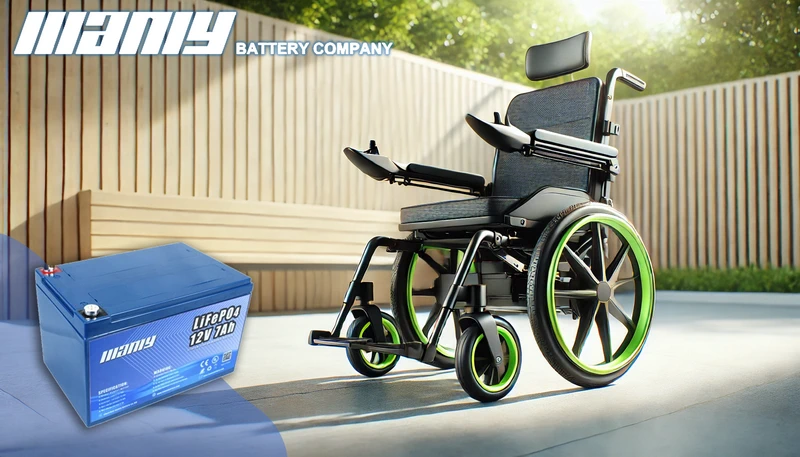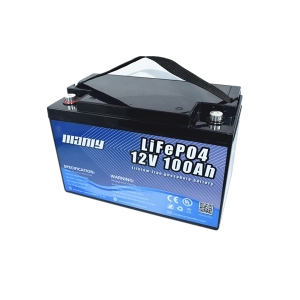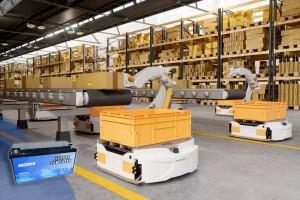¿Todas las sillas de ruedas eléctricas tienen baterías de litio?
Tabla de contenido
- ¿Todas las sillas de ruedas eléctricas tienen baterías de litio?
- Tipos de baterías utilizadas en sillas de ruedas eléctricas
- Ventajas de las baterías de litio para sillas de ruedas
- Desafíos de las baterías de litio para sillas de ruedas
- Estrategias efectivas de mantenimiento y reemplazo de baterías para sillas de ruedas
- El futuro de la tecnología de baterías para sillas de ruedas: tendencias e innovaciones
- Conclusión
- Más información sobre la batería

Tipos de baterías utilizadas en sillas de ruedas eléctricas
When selecting an electric wheelchair, one of the most crucial components to consider is the battery type. The battery not only determines how far the wheelchair can travel on a single charge but also impacts the overall weight, maintenance, and usability of the wheelchair. In this section, we'll explore the different types of batteries commonly used in electric wheelchairs: 12v wheelchair battery, Gel, AGM, and lithium wheelchair batteries.Batería para silla de ruedas de 12v
The batería de silla de ruedas de 12vEs un elemento básico en muchos diseños de sillas de ruedas eléctricas. Este tipo de batería se valora por su confiabilidad y rendimiento constante. Normalmente, se conectan dos baterías de 12 voltios en serie para proporcionar un sistema de 24 voltios, esencial para los requisitos de energía de la mayoría de las sillas de ruedas. Estas baterías suelen ser del tipo plomo-ácido, conocidas por su durabilidad y rentabilidad.Baterías de gel
Gel batteries are a type of sealed lead-acid battery, but with a twist: they use a gelified electrolyte. This gel composition helps prevent leaks and is less prone to damage if the battery casing is compromised. Gel batteries are also more stable, can handle lower temperatures, and are less likely to sulfate compared to their standard lead-acid counterparts. For wheelchair users, this means less maintenance and a reduced risk of unexpected power loss.Baterías AGM (esterilla de vidrio absorbido)
AGM batteries represent a subgroup of lead-acid batteries where the electrolyte is absorbed into a fiberglass mat. This design makes the batteries spill-proof and provides superior performance in terms of power output and charge cycles. AGM batteries are more efficient at charging and discharging than traditional lead-acid batteries, making them a preferred choice for users who need a reliable power source that can handle frequent charging cycles without deteriorating too quickly.Baterías de litio para sillas de ruedas
Lithium wheelchair batteries are becoming increasingly popular due to their lightweight and high efficiency. These batteries can charge faster and last longer than lead-acid batteries, providing more range and a lighter weight, which makes the wheelchair easier to transport and maneuver. Moreover, lithium batteries do not require the same level of maintenance as lead-acid batteries, such as regular watering. However, they are usually more expensive upfront and may require special care when charging to ensure longevity.Especificaciones técnicas
Each battery type comes with its own set of specifications. 12v wheelchair batteries typically provide a solid balance of performance and affordability but may be heavier and require more frequent replacement. Gel and AGM batteries offer better performance in terms of longevity and maintenance, with AGM usually being the more robust option in cold weather. Lithium wheelchair batteries, while the most expensive, offer the highest energy density, resulting in lighter weight and longer life spans, making them a worthwhile investment for active users.In summary, the choice of battery in an electric wheelchair impacts not only the wheelchair's performance but also its operational costs and user experience. Whether you opt for the economical 12v wheelchair battery, the durable Gel or AGM, or the high-performing lithium wheelchair batteries, understanding these options will help you make an informed decision tailored to your specific needs.Ventajas de las baterías de litio para sillas de ruedas
Lithium batteries are revolutionizing the mobility industry, particularly in the realm of electric wheelchairs. Known for their efficiency and longevity, lithium wheelchair batteries offer significant advantages over traditional battery technologies like lead-acid. This chapter explores why these batteries are becoming the preferred choice for those seeking dependable, lightweight, and environmentally friendly options in electric wheelchairs.Longevidad y confiabilidad
One of the standout benefits of lithium wheelchair batteries is their longevity. Unlike traditional batteries, which may require frequent replacements, lithium batteries can last significantly longer. They have a higher number of charge cycles, often up to 1000-2000 full charge cycles before their capacity begins to degrade. This means that a lithium battery could potentially last for several years without needing a replacement, making it a cost-effective solution in the long run.Additionally, lithium batteries maintain their charge efficiency better than their counterparts. They can discharge up to 80-90% of their capacity without significant loss in power output, ensuring that the wheelchair operates at a high performance for longer periods. This reliability is crucial for users who depend on their electric wheelchairs for daily mobility.Ventajas de peso
The weight of the battery is a critical factor in the design and functionality of electric wheelchairs. Lithium wheelchair batteries are up to 30% lighter than traditional lead-acid batteries. This reduction in weight contributes to a lighter wheelchair, which is easier to maneuver and transport. For users, this means enhanced mobility and less physical strain, particularly when loading and unloading the wheelchair from vehicles or navigating through tight spaces.Impacto medioambiental
Environmental sustainability is increasingly becoming a priority, and lithium batteries score well on this front too. They are more environmentally friendly than lead-acid batteries because they contain no hazardous lead and have a lower risk of acid leaks. Moreover, the longer lifespan of lithium batteries reduces the frequency of battery replacements and the associated environmental burden of waste and recycling.Preferencia creciente en el sector de la movilidad
The shift towards lithium technology in the mobility sector is driven not only by the benefits mentioned above but also by broader technological advancements and regulatory factors. Innovations in lithium battery technology have led to safer, more efficient batteries that meet the rigorous demands of electric wheelchair users. Regulatory pushes for greener technologies also play a role, as lithium batteries align better with environmental guidelines compared to lead-acid batteries.In conclusion, lithium wheelchair batteries represent a superior choice for modern electric wheelchairs, driven by their long life, lightweight characteristics, and minimal environmental impact. As technology continues to advance, we can expect these batteries to play an even greater role in enhancing the independence and quality of life for individuals relying on electric mobility aids. The ongoing development and adoption of lithium batteries are set to transform the electric wheelchair market, making it more accessible, sustainable, and user-friendly.Desafíos de las baterías de litio para sillas de ruedas
While baterías de litio para sillas de ruedasAunque ofrecen numerosas ventajas, también conllevan su propio conjunto de desafíos que pueden afectar la elección y la satisfacción del usuario. Este capítulo profundiza en las limitaciones y complicaciones asociadas con estas baterías, explorando aspectos como el costo, la compatibilidad y escenarios donde los tipos de baterías alternativas pueden ser más adecuados.Preocupaciones por los costos
One of the primary deterrents for many users considering baterías de litio para sillas de ruedas is the initial cost. Lithium batteries are generally more expensive than their lead-acid or gel counterparts. This higher upfront cost can be prohibitive for individuals or healthcare facilities with limited budgets. Although the long-term benefits, such as fewer replacements and lower maintenance, can offset the initial expense, the initial investment remains a significant barrier for widespread adoption.Moreover, the maintenance and replacement of lithium batteries, though less frequent, can also be more costly. Specialized equipment and knowledge are required to safely handle and dispose of lithium batteries, adding to the overall cost of ownership.Problemas de compatibilidad
Compatibility is another significant challenge with the adoption of lithium batteries in electric wheelchairs. Many existing wheelchair models are designed to operate optimally with traditional battery types, such as lead-acid. Retrofitting these models to accommodate baterías de litioPuede requerir modificaciones importantes, no solo en la carcasa de la batería sino también en los sistemas de control electrónico para manejar diferentes voltajes y corrientes. Esto puede complicar la transición a la tecnología de litio, particularmente para los usuarios que no están listos para comprar sillas de ruedas nuevas pero que buscan actualizar sus sistemas de baterías existentes.Idoneidad en ciertos escenarios
While lithium batteries excel in many use-cases due to their lightweight and high-energy density, there are scenarios where other types of batteries might be more suitable. For example, in extremely cold environments, lithium batteries can underperform as low temperatures can affect their chemical reactions, leading to reduced power output and efficiency. In such cases, gel or AGM (Absorbent Glass Mat) batteries, which are less susceptible to cold temperatures, might be a better choice.In addition, for users who require only minimal use of their electric wheelchair or for those who prioritize certain performance characteristics such as extreme durability under rough conditions, the cost-benefit ratio of lithium may not be as favorable. Here, the more robust nature of traditional batteries could be deemed more appropriate despite their heavier weight and lower efficiency.Estrategias efectivas de mantenimiento y reemplazo de baterías para sillas de ruedas
Maintaining and replacing the batteries of an electric wheelchair are crucial for ensuring optimal performance and longevity of your mobility aid. This chapter provides practical advice and tips on how to care for and when to replace the batteries in your electric wheelchair, focusing on maximizing their lifespan and ensuring continuous, reliable mobility.Mantenimiento de diferentes tipos de baterías para sillas de ruedas
The maintenance needs of wheelchair batteries can vary significantly depending on the type of battery used. Gel batteries, AGM batteries, and lithium wheelchair batteries all have different care requirements:- Baterías de gel require very little maintenance as they are sealed and do not need watering. However, it's crucial to keep them charged and avoid completely depleting the battery charge, as this can significantly shorten their lifespan.
- Baterías AGM (esterilla de vidrio absorbente) also do not need additional water and are more resistant to vibrations than gel batteries. They should be kept fully charged and stored in a cool, dry place when not in use to prevent sulfation, which can degrade the battery's capacity.
- Baterías de litio para sillas de ruedas are the most maintenance-friendly among all types, with a high energy density and no memory effect, meaning they don’t require complete discharge before recharging. Nevertheless, it's important to use a compatible charger and avoid exposing them to extreme temperatures, as heat can cause lithium batteries to degrade faster.
Elegir y reemplazar las baterías de las sillas de ruedas
When it comes time to replace your wheelchair’s battery, several factors should be considered to choose the right battery:- Compatibilidad de la batería: Ensure that the replacement battery is compatible with your wheelchair model. Voltage and capacity should match the manufacturer's specifications to avoid any issues with performance or damage to the wheelchair's motor or electronics.
- Marca y calidad: Opte por baterías de alta calidad de fabricantes acreditados. Las alternativas más económicas pueden ahorrar dinero por adelantado, pero normalmente ofrecen una vida útil más corta y un rendimiento menos confiable, lo que lleva a reemplazos más frecuentes.
- Tipo de batería: Considera el tipo de batería que mejor se adapta a tus necesidades. Las baterías de litio, aunque son más caras, tienen una vida útil más larga y requieren cargas menos frecuentes. Si le preocupan las limitaciones presupuestarias, las baterías de gel o AGM pueden ser buenas alternativas.
- Garantía y soporte: Consulta la garantía ofrecida con la batería. Un período de garantía más largo suele ser un indicador de una batería de mejor calidad. Además, comprar a un proveedor que ofrezca una buena atención al cliente puede resultar beneficioso en caso de problemas durante la vida útil de la batería.
- Apagar la silla de ruedas y retirar las conexiones de la batería.
- Retire de forma segura la batería vieja y deséchela de acuerdo con las regulaciones locales, ya que las baterías contienen materiales que pueden ser dañinos para el medio ambiente.
- Instalación de la batería nueva, asegurándose de que todas las conexiones sean seguras y correctas.
El futuro de la tecnología de baterías para sillas de ruedas: tendencias e innovaciones
As we move forward, the field of battery technology continues to evolve, offering new possibilities and improvements for electric wheelchair users. This chapter explores the significant technological advancements in the battery sector and anticipates future trends that may redefine mobility for individuals relying on electric wheelchairs.Avances tecnológicos en tecnología de baterías
In recent years, lithium wheelchair batteries have made a notable impact due to their efficiency and longevity. Unlike traditional 12v wheelchair battery systems or other chemistries like Gel and AGM, lithium batteries offer a superior energy-to-weight ratio, which is crucial for mobility applications. They charge faster, last longer, and require less frequent replacement, making them a highly beneficial investment for wheelchair users.Beyond lithium, researchers are exploring other innovative battery technologies. Solid-state batteries, for instance, promise even greater safety and energy density. These batteries replace the liquid or gel electrolytes with a solid counterpart that is less prone to leaking and can withstand higher temperatures without degrading. Such advancements could further improve the safety and performance of wheelchair batteries.Predicción de tendencias futuras en baterías para sillas de ruedas
Looking ahead, the future of wheelchair batteries is likely to be shaped by several key factors:- Sustainability: As global emphasis on environmental impact increases, there is a push towards more sustainable battery technologies. Innovations like battery recycling programs and the development of bio-degradable battery components are gaining traction. These efforts aim not only to reduce the ecological footprint but also to enhance the circular economy within the battery industry.
- Integration with Renewable Energy: With the rise of renewable energy sources, future electric wheelchairs might incorporate solar panels or other energy-harvesting technologies to extend battery life and reduce dependency on traditional charging methods. This integration could be particularly beneficial in enhancing the autonomy of wheelchair users, allowing for greater mobility without the frequent need for recharging.
- Smart Battery Management Systems (BMS): Los avances en electrónica y software han llevado al desarrollo de BMS más inteligentes que optimizan la duración y el rendimiento de la batería. Las sillas de ruedas futuras podrían emplear BMS que puedan predecir el estado de la batería y las necesidades de mantenimiento, ajustar el uso de energía según los patrones de viaje y mejorar la eficiencia general de la batería.
- Personalización y diseño específico del usuario: A medida que la tecnología se vuelve más adaptable, los futuros sistemas de baterías pueden ofrecer más opciones de personalización. Las baterías podrían diseñarse para satisfacer las necesidades específicas de usuarios individuales, considerando factores como el uso diario típico, los requisitos de peso e incluso las condiciones climáticas.
Conclusión
As we have seen, the choice of battery not only affects the performance and efficiency of electric wheelchairs but also influences the user's independence and quality of life. The ongoing advancements in battery technology, particularly the shift towards more sustainable and high-performing options like lithium wheelchair batteries, promise to further enhance these devices. With innovations such as smart battery management systems and integration with renewable energy sources on the horizon, the future of wheelchair batteries looks bright. Users can look forward to wheelchairs that are more powerful, durable, and environmentally friendly, transforming mobility and accessibility for many.




















